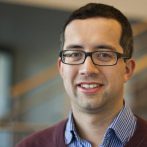BY SHEILA WATERHOUSE
RACKHAM
ORIGINAL STORY

“My research focuses on creating very tiny stars,” says Marc. Tiny stars might sound like a Disney World ride, but the complex science behind the mass production of inertial confinement fusion is nothing but groundbreaking. Falling under the category of fusion energy, inertial confinement fusion promises a clean and nearly unlimited source of energy. “Lab systems currently can create one of these stars every two days, but if we could do this six times a second, the explosions based on these little stars would create enough energy for a basic power plant.” Marc explains, “My research studies these systems and their fundamental physics in order to improve the technology.”
And there’s much to do. Marc works on many of the current limitations that prevent scientists from achieving fusion. Broadly applied, this research falls under fluid dynamics. He explains, “Some of the fundamental processes that happen in these fusion systems specifically involve the mixing of different materials during the creation of this tiny star. If we zoom out of that application, this type of work is applicable to understanding astrophysical phenomena, like actual stars exploding, and planets forming, and types of problems that arise in combustion processes.” Understanding these high speed flows where material mixing occurs is also critical for non-invasive biomedical treatments, like using ultrasound to destroy tumors or deliver genes to specific cells. He says, “Tiny bubbles are created near tumor cells. Ultrasound excites the bubbles; the bubbles then violently collapse and destroy the cancerous tissue.”
His research is multifaceted, falling under three broad categories: developing more efficient numerical methods to solve equations, using U-M’s supercomputers to simulate complex systems, and providing a new physical understanding of high speed multi-material flows relevant to many engineering and biomedical applications. He describes, “My work bounces back and forth between working on supercomputers, understanding the physics, and developing tools to solve the equations that define the physical problems.”
Marc found a passion for research through internships at the Lawrence Livermore National Laboratory in California during his undergraduate years. Born and educated in Belgium to a Belgian dad and American mom, Marc leveraged those internships to apply to grad school in the United States. It was through those connections that he found ME Assistant Professor Eric Johnsen, his current advisor.
Like all good engineers, he tinkers around and builds things. He adds, “I play in a lot of soccer leagues here, hike outdoors, like to cook, and I try never to work on weekends. I impose strict rules on work life balance.” As the president of the Mechanical Engineering Graduate Council, he organizes a lot of activities to get students out of the lab, some of which are purely social and some have academic or professional applications.
